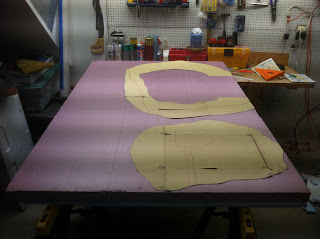I started with a 50x100 inch vinyl grass mat from Woodland
scenics, and after spending $32 for the material at my local hobby shop and carefully cutting out my roads, shorelines, etc. I came to the frustrating decision to remove the mat because nothing I tried could make it actually stick to my contours. I should note that I did not have a proper heat gun and that the temperature in my garage was in the 40 degree range.
Too, something I really did not consider to be a significant problem turned into one - the way that I was installing the mat gave it no stretch, so I had problems forming the grass mat to my hills.
Below are pictures of the grass mat process from it's start to the "last straw" issue that made me pull it all up. - my inability to shape this material around my hills. That all said, I kept a big piece of the gass mat to experiment with after I pick up a heat gun.
























